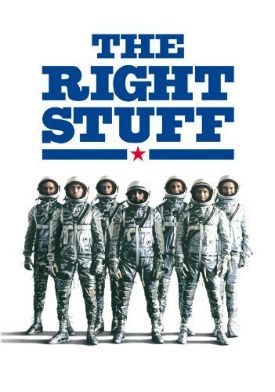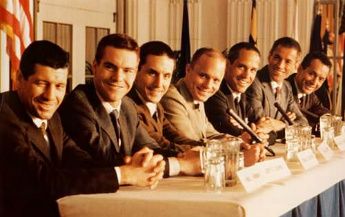
The Right Stuff
Director: Philip Kaufman
Starring: Sam Shephard, Dennis Quaid, Ed Harris, Scott Glenn
1983
Unquestionably one the best American films to emerge in the 1980’s, spicing up a decade that is a veritable wasteland when it comes to Hollywood productions, The Right Stuff is a gripping tale of the early days of the space program, starting with the breaking of the sound barrier in 1947 and ending in 1963 with the conclusion of the Mercury missions.
The film’s major strength is its approach to the story. Chronologically speaking, it’s told in a linear fashion, yet the film hardly fits into a standard Hollywood historical retelling mold. Interesting but seemingly historically unimportant episodes are given heavy weight, while certain historically significant events, such as John Glenn’s dangerous re-entry with a handicapped craft, are not shown. It’s fascinating watching the “behind the scenes” tales play out, and the film feels fresh because of it. It’s not so much about the technology but the people, especially the people. Furthermore, Kaufman is a careful and philosophical director, unafraid to spin off into tantalizing tangents, or to suggest at further, unexplored story lines. What really happened, after all, with those two hot girls at the bar who said, “Four down, three to go”? It’s a small scene that doesn’t have much to do with anything else, but it’s a delicious little hint at other stories left untold. In one of the few truly taut moments, when Gus Grissom (played by Fred Ward) is suffering from claustrophobia inside his water-landed pod, we don’t see whether Grissom blew the hatch himself or whether it happened by accident, as he always claimed. Kaufman cut away to the outside of the shuttle so we don’t know what went on inside. There is a mystery there, and Kaufman wants to preserve it, not resolve it. The intercutting between the NASA developments and Chuck Yeager, test pilot extraordinaire, is vital in shaping the overall film, constantly reminding us of the true roots of the astronauts as their fame and paparazzi following grow to absurd heights.
Sam Shephard plays Chuck Yeager. He was nominated for an Academy Award for Best Supporting Actor for his work. I find this hard to believe; not that he was nominated, but that it was a supporting role. All things considered, Shephard must speak only about four or five dozen lines as Yeager, but his presence is overwhelming. He is the movie. He is Yeager. He is most certainly made of The Right Stuff. For all the hard, tough work the astronauts go through, everything cycles back to Yeager. I have a feeling that Shephard – playwright, actor by accident, general artist, and definitely not caring what the world thinks of him – is very much cut from the same cloth as Yeager. Here is a man, quietly confident, who lives his life through his actions and not his words. He silently stares down the planes, quietly evaluating, almost as if he is sizing them up; how fast will this one take me? How high will this one take me?

In an early scene with Yeager, he is riding his horse through the Arizona desert and he comes upon a new test plane, all by itself, being refueled. A strange sight indeed, he stares the lone, noisy plane down; there is no dialogue, and minimalist music plays forebodingly in the background. A scene like this is far more reminiscent of the elliptical and dreamlike work of Nicolas Roeg in the 1970’s than of Kaufman’s Hollywood contemporaries. It all serves to lend the film an air of mysticism, underlining that these men, these missions are truly otherworldly. Yeager is not one of us, not one of the many; he stands apart.
The film is rife with the distinction between the stoic Yeager and the hotdoggin’ man-child Gordo Cooper, played with obnoxious childlike glee by Dennis Quaid. There is little doubt who is the better man between the two, and yet it is Gordo Cooper who joins the Mercury program, Cooper who becomes an astronaut; Yeager is not even considered for the program because he did not go to college, a prerequisite. It’s fascinating following Cooper through the film as he moves from the Arizona test pilot facility where he can’t even bring himself to engage Yeager in conversation, to the NASA entry tests where he is one of many overconfident flyboys, to the space program where he finally seems to mature with his six cohorts. Meanwhile, there is constantly Yeager, still in Arizona, still a test pilot, still chasing the devil in the sky, with no sense of wistful regret. He is not sad he was not chosen; rather, in his longest speech of the film, he speaks of the heroism of astronauts, sitting on top of gallons of fuel that could blow them up at any minute. And then, one would imagine, he goes right back out into his test plane and tries to break the speed record… again.

Just as much as this movie is about the men involved in the early space program, it is also about the women in their lives. These women are just as varied in personality as the men; and none fit into a single mold. All of the wives and female characters are just as strong-willed, just as fierce, and just as determined as the men. Barbara Hershey plays Yeager’s wife, a woman so willful, it’s almost dangerous. One of the most touching scenes in the film is between Ed Harris’ John Glenn and his shy, stuttering wife, as he ferociously shields her from an insistent press, including the Vice President LBJ. The women behind the men are all just as interesting, and are given their due in this story.
The humor of the film is both plentiful and unexpected. When making a movie about men who have a one in four chance of dying every time they go up in a plane, one does not immediately think “laugh riot,” yet there is a lightness to this film, often helped by comedy. Harry Shearer and a very young, wow-those-are-some-ears Jeff Goldblum play a team of early NASA organizers who recruit the astronauts. As one can imagine, when pairing Shearer and Goldblum together, they are truly funny, especially as they’re trying to sell President Eisenhower on picking the first astronauts from surfers and circus performers. Then there’s the series of shots from the early NASA unmanned rockets – the unsuccessful rockets. A caricature of a scientist, always pressing the launch button, becomes more and more dejected as the rockets repeatedly crash. When one rocket actually makes it off the ground about 500 yards, he grins with relief, only to then watch the rocket explode in the middle of the sky. His grin slowly fades; he is a sad, dejected scientist. As serious as it sounds, it’s a funny scene. Similar scenes are laced throughout the film, ensuring that the film never becomes too heavy, too serious. There is a gravitas to it, certainly, but the drama is always entertaining and never crushing. For a film that is 193 minutes, it’s essential that it stays entertaining; the humor, like a too-slow elevator when Alan Shephard has to use the bathroom, keeps the film briskly paced.
Mention must be made of the score. The original compositions are pitch perfect, with the main theme full of heroism and fanfare, sounding rather like an American anthem that you can’t quite place. This wonderful theme is undercut with lesser themes of much greater ambiguity and danger, almost as if they are the themes not to the ticker tape parade down Fifth Avenue, but rather the music that would be playing in one of these men’s heads as they sit in their test aircraft, uncertain of their very lives. The previously written works (including a cleverly placed “Russian Sailor’s Dance” by Gliere, and “Mars,” “Jupiter,” and “Neptune” from Holst’s “The Planets Suite”) fit achingly well within the film, providing awe and pathos, especially in a haunting scene using Debussy’s “Clair de Lune.” This last tune can be clichéd if not done well; here, it’s played at a Texas gala for the astronauts as they watch a vaudeville fan dancer. Not nearly so much about the stripper as it is about her shadow onstage – she is backlit from the floor, highlighting all the tiny threads of her fans – the song follows the men as they look around and take in how far they’ve come. Right on cue, however, the song cuts out and the story cuts back to Yeager, and the music changes accordingly. Yeager would never listen to Clair de Lune.
Kaufman battled with the early writers involved on the project who didn’t see Yeager as a necessary figure in the movie and wanted to cut him entirely. Kaufman was insistent, however, as he knew that it was Yeager’s tale that would constantly provide perspective and comparison to that of the Mercury astronauts. Thank goodness he stuck to his guns.
This is a movie that is slowly and silently growing in my esteem. It is carefully weaseling its way into my "Favorite Movies Ever" list, and good on it. I once tried only watching about half an hour of it when I was home alone for dinner. I wound up watching the entire thing without meaning to. A movie that can do that is incredible.
Arbitrary Rating: 10/10
There is no better moment in this film for me than Yeager walking away from that wreck at the end. He's destroyed a multi-million dollar aircraft by trying to take it out of the atmosphere, and when it fails, he sends it straight into the dirt, and his reaction is just to walk away from it, back for more. That shot of Yeager walking out of the desert stays with me.
ReplyDeleteOh, I agree. It's so triumphant for what is really a bad crash. And that it ends with Yeager is SO important!
DeleteYou should do a post on some of your favorite final shots from a film. 3-Iron, this movie, etc... That would be interesting!